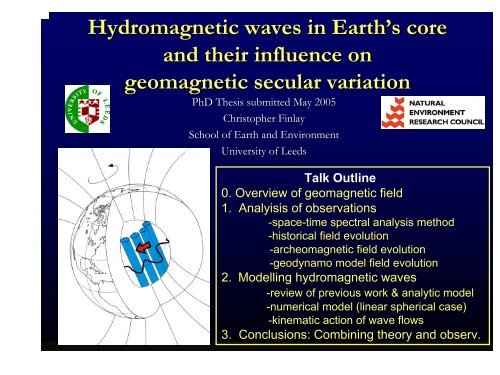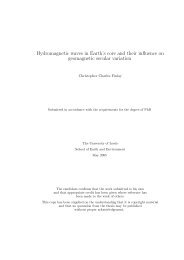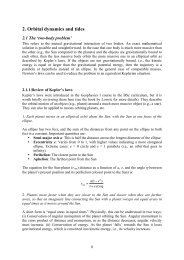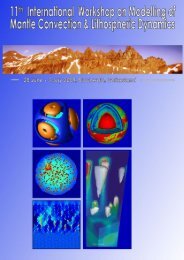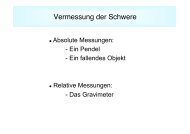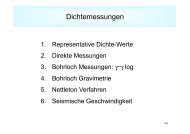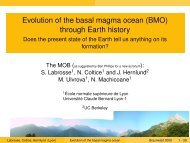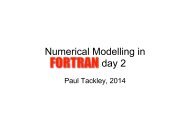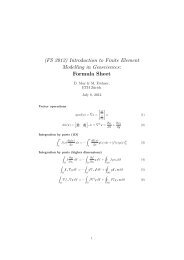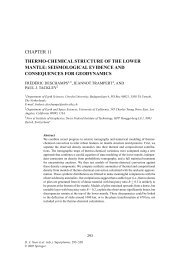Hydromagnetic waves in Earth's core and their influence on ...
Hydromagnetic waves in Earth's core and their influence on ...
Hydromagnetic waves in Earth's core and their influence on ...
Create successful ePaper yourself
Turn your PDF publications into a flip-book with our unique Google optimized e-Paper software.
<str<strong>on</strong>g>Hydromagnetic</str<strong>on</strong>g> <str<strong>on</strong>g>waves</str<strong>on</strong>g> <str<strong>on</strong>g>in</str<strong>on</strong>g> Earth’s s <str<strong>on</strong>g>core</str<strong>on</strong>g><br />
<str<strong>on</strong>g>and</str<strong>on</strong>g> <str<strong>on</strong>g>their</str<strong>on</strong>g> <str<strong>on</strong>g>in</str<strong>on</strong>g>fluence <strong>on</strong><br />
geomagnetic secular variati<strong>on</strong><br />
PhD Thesis submitted May 2005<br />
Christopher F<str<strong>on</strong>g>in</str<strong>on</strong>g>lay<br />
School of Earth <str<strong>on</strong>g>and</str<strong>on</strong>g> Envir<strong>on</strong>ment<br />
University of Leeds<br />
Talk Outl<str<strong>on</strong>g>in</str<strong>on</strong>g>e<br />
0. Overview of geomagnetic field<br />
1. Analyisis of observati<strong>on</strong>s<br />
-space-time spectral analysis method<br />
-historical field evoluti<strong>on</strong><br />
-archeomagnetic field evoluti<strong>on</strong><br />
-geodynamo model field evoluti<strong>on</strong><br />
2. Modell<str<strong>on</strong>g>in</str<strong>on</strong>g>g hydromagnetic <str<strong>on</strong>g>waves</str<strong>on</strong>g><br />
-review of previous work & analytic model<br />
-numerical model (l<str<strong>on</strong>g>in</str<strong>on</strong>g>ear spherical case)<br />
-k<str<strong>on</strong>g>in</str<strong>on</strong>g>ematic acti<strong>on</strong> of wave flows<br />
3. C<strong>on</strong>clusi<strong>on</strong>s: Comb<str<strong>on</strong>g>in</str<strong>on</strong>g><str<strong>on</strong>g>in</str<strong>on</strong>g>g theory <str<strong>on</strong>g>and</str<strong>on</strong>g> observ.
Motivati<strong>on</strong>: Our magnetic shield<br />
• Earth’s s magnetic field shields the planet from the solar w<str<strong>on</strong>g>in</str<strong>on</strong>g>d<br />
• But the field is not steady, rather is fluctuat<str<strong>on</strong>g>in</str<strong>on</strong>g>g<br />
• Aim: to better underst<str<strong>on</strong>g>and</str<strong>on</strong>g> mechanisms of field variati<strong>on</strong>
Geomagnetic field observati<strong>on</strong>s<br />
• Permanent observatories<br />
• Maritime observati<strong>on</strong>s<br />
• Repeat surveys<br />
• Satellites<br />
Portable fluxgate<br />
magnetometer<br />
CHAMP<br />
Hadley magnetic<br />
observatory
Geomagnetic field evoluti<strong>on</strong><br />
• Radial magnetic field B r at the <str<strong>on</strong>g>core</str<strong>on</strong>g> surface 1590-1990
Field evoluti<strong>on</strong> mechanisms<br />
• How can <str<strong>on</strong>g>core</str<strong>on</strong>g> moti<strong>on</strong>s (<str<strong>on</strong>g>in</str<strong>on</strong>g>clud<str<strong>on</strong>g>in</str<strong>on</strong>g>g those <str<strong>on</strong>g>in</str<strong>on</strong>g>volved <str<strong>on</strong>g>in</str<strong>on</strong>g> the<br />
geodynamo mechanism) produce observed field changes<br />
• Advecti<strong>on</strong> of field l<str<strong>on</strong>g>in</str<strong>on</strong>g>es with flows close to the <str<strong>on</strong>g>core</str<strong>on</strong>g> surface<br />
(Example of a<br />
<str<strong>on</strong>g>core</str<strong>on</strong>g> flow<br />
<str<strong>on</strong>g>in</str<strong>on</strong>g>versi<strong>on</strong>,<br />
assum<str<strong>on</strong>g>in</str<strong>on</strong>g>g<br />
advecti<strong>on</strong> as the<br />
source of field<br />
evoluti<strong>on</strong>,<br />
from Jacks<strong>on</strong>’97)<br />
• or flux expulsi<strong>on</strong> <str<strong>on</strong>g>and</str<strong>on</strong>g> diffusi<strong>on</strong>: new field at <str<strong>on</strong>g>core</str<strong>on</strong>g> surface<br />
• or hydromagnetic wave propagati<strong>on</strong>
What are hydromagnetic <str<strong>on</strong>g>waves</str<strong>on</strong>g><br />
• <str<strong>on</strong>g>Hydromagnetic</str<strong>on</strong>g> <str<strong>on</strong>g>waves</str<strong>on</strong>g> arise due to the<br />
elasticity given to fluids by the presence<br />
of a magnetic fields<br />
• When magnetic fields are distorted by<br />
flow, they resp<strong>on</strong>d via a Lorentz force<br />
act<str<strong>on</strong>g>in</str<strong>on</strong>g>g to oppose the distorti<strong>on</strong><br />
• In Earth’s s <str<strong>on</strong>g>core</str<strong>on</strong>g>, Coriolis <str<strong>on</strong>g>and</str<strong>on</strong>g> buoyancy<br />
forces are also <str<strong>on</strong>g>in</str<strong>on</strong>g>volved <str<strong>on</strong>g>in</str<strong>on</strong>g> the force<br />
balance <str<strong>on</strong>g>and</str<strong>on</strong>g> determ<str<strong>on</strong>g>in</str<strong>on</strong>g>e wave properties<br />
Observable<br />
Poloidal field<br />
Columnar<br />
wave flow<br />
• Slow <str<strong>on</strong>g>waves</str<strong>on</strong>g> with time scales of hundreds<br />
to thous<str<strong>on</strong>g>and</str<strong>on</strong>g>s of years are possible when<br />
Coriolis forces act to balance the Lorentz<br />
forces (MC <str<strong>on</strong>g>waves</str<strong>on</strong>g>)<br />
• Time scales ~ westward drift suggest a<br />
possible mechanism of field evoluti<strong>on</strong><br />
Wave drifts<br />
azimuthally<br />
Toroidal field<br />
with<str<strong>on</strong>g>in</str<strong>on</strong>g> fluid <str<strong>on</strong>g>core</str<strong>on</strong>g><br />
distorted by wave
Thesis aims<br />
To <str<strong>on</strong>g>in</str<strong>on</strong>g>vestigate of hydromagnetic <str<strong>on</strong>g>waves</str<strong>on</strong>g> as a source of<br />
geomagnetic field variati<strong>on</strong> by:<br />
• Study<str<strong>on</strong>g>in</str<strong>on</strong>g>g observati<strong>on</strong>s of geomagnetic field evoluti<strong>on</strong><br />
(historical <str<strong>on</strong>g>and</str<strong>on</strong>g> archeomagnetic) ) for evidence of <str<strong>on</strong>g>waves</str<strong>on</strong>g><br />
• Study<str<strong>on</strong>g>in</str<strong>on</strong>g>g geodynamo models for evidence of <str<strong>on</strong>g>waves</str<strong>on</strong>g> <str<strong>on</strong>g>and</str<strong>on</strong>g><br />
prob<str<strong>on</strong>g>in</str<strong>on</strong>g>g the underly<str<strong>on</strong>g>in</str<strong>on</strong>g>g mechanisms<br />
• Us<str<strong>on</strong>g>in</str<strong>on</strong>g>g hydromagnetic wave theory <str<strong>on</strong>g>and</str<strong>on</strong>g> numerical modell<str<strong>on</strong>g>in</str<strong>on</strong>g>g<br />
to better underst<str<strong>on</strong>g>and</str<strong>on</strong>g> wave properties <str<strong>on</strong>g>and</str<strong>on</strong>g> effect <strong>on</strong> B r<br />
• Comb<str<strong>on</strong>g>in</str<strong>on</strong>g><str<strong>on</strong>g>in</str<strong>on</strong>g>g observati<strong>on</strong>s <str<strong>on</strong>g>and</str<strong>on</strong>g> theory: : are they compatible
Talk Outl<str<strong>on</strong>g>in</str<strong>on</strong>g>e<br />
0. Overview of geomagnetic field<br />
1. Analyisis of observati<strong>on</strong>s<br />
-space-time spectral analysis method<br />
-historical field evoluti<strong>on</strong><br />
-archeomagnetic field evoluti<strong>on</strong><br />
-geodynamo model field evoluti<strong>on</strong><br />
2.Modell<str<strong>on</strong>g>in</str<strong>on</strong>g>g hydromagnetic <str<strong>on</strong>g>waves</str<strong>on</strong>g><br />
-review of previous work & analytic model<br />
-numerical model (l<str<strong>on</strong>g>in</str<strong>on</strong>g>ear spherical case)<br />
-k<str<strong>on</strong>g>in</str<strong>on</strong>g>ematic acti<strong>on</strong> of wave flows<br />
3. C<strong>on</strong>clusi<strong>on</strong>s
Time-l<strong>on</strong>gitude plots<br />
• For azimuthal (east-west) field moti<strong>on</strong>s, choose a<br />
latitude of <str<strong>on</strong>g>in</str<strong>on</strong>g>terest, to c<strong>on</strong>struct time-l<strong>on</strong>gitude plots<br />
• used <str<strong>on</strong>g>in</str<strong>on</strong>g> meteorology <str<strong>on</strong>g>and</str<strong>on</strong>g><br />
oceanography to study <str<strong>on</strong>g>waves</str<strong>on</strong>g><br />
• gradients give speeds of features
Frequency-wavenumber<br />
spectra<br />
Taper ends of time series<br />
Zero pad time series<br />
Take FFT <str<strong>on</strong>g>in</str<strong>on</strong>g> time<br />
Take FFT <str<strong>on</strong>g>in</str<strong>on</strong>g> l<strong>on</strong>gitude<br />
Plot square of amplitudes
Speed determ<str<strong>on</strong>g>in</str<strong>on</strong>g>ati<strong>on</strong> <str<strong>on</strong>g>and</str<strong>on</strong>g> use of<br />
the Rad<strong>on</strong> transform<br />
= -30 o<br />
• The Rad<strong>on</strong> transform is the projecti<strong>on</strong> of a 2D image al<strong>on</strong>g the directi<strong>on</strong><br />
normal to the l<str<strong>on</strong>g>in</str<strong>on</strong>g>e def<str<strong>on</strong>g>in</str<strong>on</strong>g>ed by the angle q<br />
• High amplitudes of the Rad<strong>on</strong> transform occur where field features <str<strong>on</strong>g>in</str<strong>on</strong>g><br />
the TL plot move coherently at an angle 90 + q to the x axis
Speed determ<str<strong>on</strong>g>in</str<strong>on</strong>g>ati<strong>on</strong> <str<strong>on</strong>g>and</str<strong>on</strong>g> use of<br />
the Rad<strong>on</strong> transform (II)
Field Process<str<strong>on</strong>g>in</str<strong>on</strong>g>g (I): Removal of<br />
time-averaged<br />
axisymmetric field<br />
= -30 o
Field Process<str<strong>on</strong>g>in</str<strong>on</strong>g>g (II): High pass<br />
filter<str<strong>on</strong>g>in</str<strong>on</strong>g>g<br />
Filter threshold<br />
t c =400 years<br />
= -30 o
Talk Outl<str<strong>on</strong>g>in</str<strong>on</strong>g>e<br />
0. Overview of geomagnetic field<br />
1. Analyisis of observati<strong>on</strong>s<br />
-space-time spectral analysis method<br />
-historical field evoluti<strong>on</strong><br />
-archeomagnetic field evoluti<strong>on</strong><br />
-geodynamo model field evoluti<strong>on</strong><br />
2.Modell<str<strong>on</strong>g>in</str<strong>on</strong>g>g hydromagnetic <str<strong>on</strong>g>waves</str<strong>on</strong>g><br />
-review of previous work & analytic model<br />
-numerical model (l<str<strong>on</strong>g>in</str<strong>on</strong>g>ear spherical case)<br />
-k<str<strong>on</strong>g>in</str<strong>on</strong>g>ematic acti<strong>on</strong> of wave flows<br />
3. C<strong>on</strong>clusi<strong>on</strong>s
Historical field evoluti<strong>on</strong>: gufm1<br />
(Jacks<strong>on</strong>, J<strong>on</strong>kers <str<strong>on</strong>g>and</str<strong>on</strong>g> Walker 2000)<br />
• 365 694 observati<strong>on</strong>s from 1590 to 1990<br />
• Maritime, observatory, survey <str<strong>on</strong>g>and</str<strong>on</strong>g> satellite data <str<strong>on</strong>g>in</str<strong>on</strong>g>cluded<br />
• Time-dependent field model (spherical harm<strong>on</strong>ic <str<strong>on</strong>g>and</str<strong>on</strong>g> cubic B-spl<str<strong>on</strong>g>in</str<strong>on</strong>g>e)<br />
• Suitable for study<str<strong>on</strong>g>in</str<strong>on</strong>g>g field at <str<strong>on</strong>g>core</str<strong>on</strong>g> surface: regularised <str<strong>on</strong>g>in</str<strong>on</strong>g> space & time<br />
• Number of observati<strong>on</strong>s <str<strong>on</strong>g>and</str<strong>on</strong>g> spatial coverage varies with time<br />
• Accuracy of model is best <str<strong>on</strong>g>in</str<strong>on</strong>g> 20 th century, but still good at earlier times
gufm1: Processed B r with t c =400yrs (II)<br />
Equator<br />
20 degrees North
gufm1: Processed B r with t c =400yrs (III)<br />
-<br />
-
m=7<br />
T=125yrs<br />
to 333yrs<br />
gufm1: FK filter<str<strong>on</strong>g>in</str<strong>on</strong>g>g to isolate modes<br />
m=5<br />
T=125yrs<br />
to 333yrs<br />
m=3<br />
T=125yrs<br />
to 333yrs
gufm1: Dispersi<strong>on</strong><br />
• Difficult: need same source, so restrict to s<str<strong>on</strong>g>in</str<strong>on</strong>g>gle latitude: equator<br />
• Then <strong>on</strong>ly significant power over small spread of wavenumbers<br />
• No str<strong>on</strong>g evidence for dispersi<strong>on</strong>, ignor<str<strong>on</strong>g>in</str<strong>on</strong>g>g weak signals, hypothesis<br />
of no dispersi<strong>on</strong> can expla<str<strong>on</strong>g>in</str<strong>on</strong>g> observated field evoluti<strong>on</strong>
gufm1: Geographical trends <str<strong>on</strong>g>in</str<strong>on</strong>g> speeds<br />
• Apply<str<strong>on</strong>g>in</str<strong>on</strong>g>g Rad<strong>on</strong> transform speed determ<str<strong>on</strong>g>in</str<strong>on</strong>g>ati<strong>on</strong> to l<strong>on</strong>gitude<br />
sub-w<str<strong>on</strong>g>in</str<strong>on</strong>g>dows<br />
• User def<str<strong>on</strong>g>in</str<strong>on</strong>g>ed threshold; <strong>on</strong>ly str<strong>on</strong>gest signals shown<br />
• Speeds generally faster under south America<br />
• No clear trends as a functi<strong>on</strong> of latitude or l<strong>on</strong>gitude
gufm1: Temporal evoluti<strong>on</strong><br />
1750 1850 1910<br />
• Can use Rad<strong>on</strong> transform method with sub-w<str<strong>on</strong>g>in</str<strong>on</strong>g>dows <str<strong>on</strong>g>in</str<strong>on</strong>g> time to<br />
<str<strong>on</strong>g>in</str<strong>on</strong>g>vestigate temporal evoluti<strong>on</strong>, but lose velocity resoluti<strong>on</strong><br />
• Str<strong>on</strong>g equatorial signal present throughout record<br />
• In 20 th century str<strong>on</strong>g westward signal at mid-latitudes <str<strong>on</strong>g>in</str<strong>on</strong>g> southern<br />
hemisphere<br />
• Mechanism of field evoluti<strong>on</strong> not stati<strong>on</strong>ary, but evolve over centuries
Summary of study of historical field<br />
• Spatially <str<strong>on</strong>g>and</str<strong>on</strong>g> temporally coherent (wave-like) patterns of<br />
field evoluti<strong>on</strong> exist<br />
• Str<strong>on</strong>gest, most persistent, signal is m=5, T=250yrs,<br />
travell<str<strong>on</strong>g>in</str<strong>on</strong>g>g at ~17kmyr -1 westwards at the equator<br />
• Evidence for m=7 <str<strong>on</strong>g>and</str<strong>on</strong>g> m=3 signals <str<strong>on</strong>g>and</str<strong>on</strong>g> a weak<br />
eastward signal at mid-latiudes<br />
• Mechanisms produc<str<strong>on</strong>g>in</str<strong>on</strong>g>g field evoluti<strong>on</strong> are not stati<strong>on</strong>ary<br />
• No str<strong>on</strong>g evidence for either dispersi<strong>on</strong> or simple<br />
latitud<str<strong>on</strong>g>in</str<strong>on</strong>g>al trends <str<strong>on</strong>g>in</str<strong>on</strong>g> azimuthal speeds
Talk Outl<str<strong>on</strong>g>in</str<strong>on</strong>g>e<br />
0. Overview of geomagnetic field<br />
1. Analyisis of observati<strong>on</strong>s<br />
-space-time spectral analysis method<br />
-historical field evoluti<strong>on</strong><br />
-archeomagnetic field evoluti<strong>on</strong><br />
-geodynamo model field evoluti<strong>on</strong><br />
2.Modell<str<strong>on</strong>g>in</str<strong>on</strong>g>g hydromagnetic <str<strong>on</strong>g>waves</str<strong>on</strong>g><br />
-review of previous work & analytic model<br />
-numerical model (l<str<strong>on</strong>g>in</str<strong>on</strong>g>ear spherical case)<br />
-k<str<strong>on</strong>g>in</str<strong>on</strong>g>ematic acti<strong>on</strong> of wave flows<br />
3. C<strong>on</strong>clusi<strong>on</strong>s
Archeomagnetic field evoluti<strong>on</strong>:<br />
CALS7K.1 (Korte<br />
<str<strong>on</strong>g>and</str<strong>on</strong>g> C<strong>on</strong>stable 2005)<br />
• 32 653 observati<strong>on</strong>s from 5000 B.C to 1950 A. D.<br />
• From deposti<strong>on</strong>al remanent magnetisati<strong>on</strong> <str<strong>on</strong>g>in</str<strong>on</strong>g> lake sediments an<br />
thermal remanent magnetisati<strong>on</strong> <str<strong>on</strong>g>in</str<strong>on</strong>g> lavas <str<strong>on</strong>g>and</str<strong>on</strong>g> archeological artefacts<br />
• Time-dependent field model (spherical harm<strong>on</strong>ic <str<strong>on</strong>g>and</str<strong>on</strong>g> cubic B-spl<str<strong>on</strong>g>in</str<strong>on</strong>g>e)<br />
• Suitable for study<str<strong>on</strong>g>in</str<strong>on</strong>g>g field at <str<strong>on</strong>g>core</str<strong>on</strong>g> surface: regularised <str<strong>on</strong>g>in</str<strong>on</strong>g> space & time<br />
• Number of observati<strong>on</strong>s <str<strong>on</strong>g>and</str<strong>on</strong>g> spatial coverage varies with time<br />
• Accuracy of model is best <str<strong>on</strong>g>in</str<strong>on</strong>g> last 3000 years<br />
Lake<br />
sediment<br />
sites<br />
c<strong>on</strong>centrati<strong>on</strong><br />
Lavas<br />
(directi<strong>on</strong>al)<br />
Lavas<br />
(<str<strong>on</strong>g>in</str<strong>on</strong>g>tensity)<br />
(Decl<str<strong>on</strong>g>in</str<strong>on</strong>g>ati<strong>on</strong> measurements <str<strong>on</strong>g>in</str<strong>on</strong>g><br />
Europe as a functi<strong>on</strong> of time)
CALS7K.1: Comparis<strong>on</strong> with gufm1<br />
• Can no l<strong>on</strong>ger use t c =400 years as CALS7K.1 c<strong>on</strong>ta<str<strong>on</strong>g>in</str<strong>on</strong>g>s little power<br />
<strong>on</strong> this time scale. Instead t c =2500yrs<br />
• Lack of data <str<strong>on</strong>g>in</str<strong>on</strong>g> southern <str<strong>on</strong>g>and</str<strong>on</strong>g> Pacific hemispheres<br />
• C<strong>on</strong>ta<str<strong>on</strong>g>in</str<strong>on</strong>g>s little power at spherical harm<strong>on</strong>ic degrees > 5<br />
• Azimuthal directi<strong>on</strong> of field evoluti<strong>on</strong> captured correctly<br />
gufm1:<br />
CALS7K.1:
CALS7K.1: wave-like field<br />
evoluti<strong>on</strong><br />
At 40 0 North<br />
At Equator<br />
• Spatially <str<strong>on</strong>g>and</str<strong>on</strong>g> temporally coherently field evoluti<strong>on</strong> patterns<br />
• Episodes of both westwards <str<strong>on</strong>g>and</str<strong>on</strong>g> eastwards (esp. at northern mid lat.) moti<strong>on</strong>s<br />
• Coexistence of eastward <str<strong>on</strong>g>and</str<strong>on</strong>g> westward moti<strong>on</strong>s
Summary of study of<br />
archeomagnetic field<br />
• Spatially <str<strong>on</strong>g>and</str<strong>on</strong>g> temporally coherent (wave-like) patterns of<br />
field evoluti<strong>on</strong> exist<br />
• Difficult to accurately determ<str<strong>on</strong>g>in</str<strong>on</strong>g>e wavenumbers <str<strong>on</strong>g>and</str<strong>on</strong>g> periods<br />
due to limitati<strong>on</strong>s of spatial <str<strong>on</strong>g>and</str<strong>on</strong>g> temporal resoluti<strong>on</strong><br />
• Evidence for eastward moti<strong>on</strong>s of field features,<br />
espcially at northern mid-latitudes from 0 to 1500 A.D.
Talk Outl<str<strong>on</strong>g>in</str<strong>on</strong>g>e<br />
0. Overview of geomagnetic field<br />
1. Analyisis of observati<strong>on</strong>s<br />
-space-time spectral analysis method<br />
-historical field evoluti<strong>on</strong><br />
-archeomagnetic field evoluti<strong>on</strong><br />
-geodynamo model field evoluti<strong>on</strong><br />
2.Modell<str<strong>on</strong>g>in</str<strong>on</strong>g>g hydromagnetic <str<strong>on</strong>g>waves</str<strong>on</strong>g><br />
-review of previous work & analytic model<br />
-numerical model (l<str<strong>on</strong>g>in</str<strong>on</strong>g>ear spherical case)<br />
-k<str<strong>on</strong>g>in</str<strong>on</strong>g>ematic acti<strong>on</strong> of wave flows<br />
3. C<strong>on</strong>clusi<strong>on</strong>s
Analysis of geodynamo models<br />
(model of Wicht 2002)<br />
• Apply same methods to dynamo output to study possible mechanisms<br />
• Ouput from c<strong>on</strong>vecti<strong>on</strong> driven geodynamo model MAGIC of Wicht ’02<br />
• 3D, fully n<strong>on</strong>-l<str<strong>on</strong>g>in</str<strong>on</strong>g>ear, spherical shell model of Bouss<str<strong>on</strong>g>in</str<strong>on</strong>g>esq c<strong>on</strong>vecti<strong>on</strong><br />
• B.C. are no slip, electrically <str<strong>on</strong>g>in</str<strong>on</strong>g>sulat<str<strong>on</strong>g>in</str<strong>on</strong>g>g <str<strong>on</strong>g>and</str<strong>on</strong>g> isothermal<br />
• Driven by applied temperature difference between <str<strong>on</strong>g>in</str<strong>on</strong>g>ner <str<strong>on</strong>g>and</str<strong>on</strong>g> outer <str<strong>on</strong>g>core</str<strong>on</strong>g><br />
• Two models studied: DYN1- simple model to study mechanisms<br />
DYN2- more Earth-like but also more complex<br />
• N<strong>on</strong>-dimensi<strong>on</strong>al parameters compared to Earth:
DYN1: B r at outer boundary
DYN1: u r at outer boundary
DYN1: Time-l<strong>on</strong>gitude plots<br />
Processed B r (t c =0.065 τ η<br />
−1<br />
)<br />
0.077 τ η<br />
u ø<br />
u r<br />
14 0 N
DYN2: Time-l<strong>on</strong>gitude plots<br />
0.100 τ η<br />
B r<br />
Damped B r<br />
u r<br />
20 0 S
Summary of geodynamo study<br />
• Spatially <str<strong>on</strong>g>and</str<strong>on</strong>g> temporally coherent (wave-like) patterns of<br />
field evoluti<strong>on</strong> are also observed <str<strong>on</strong>g>in</str<strong>on</strong>g> geodynamo models<br />
• Azimuthally drift<str<strong>on</strong>g>in</str<strong>on</strong>g>g B r c<strong>on</strong>centrati<strong>on</strong>s form at <str<strong>on</strong>g>and</str<strong>on</strong>g> move<br />
al<strong>on</strong>g with downwell<str<strong>on</strong>g>in</str<strong>on</strong>g>gs (positi<strong>on</strong>s of fluid c<strong>on</strong>vergence)<br />
<str<strong>on</strong>g>in</str<strong>on</strong>g> observed wave flows<br />
• Wave flow pattern is mov<str<strong>on</strong>g>in</str<strong>on</strong>g>g more slowly than speeds<br />
of flow with<str<strong>on</strong>g>in</str<strong>on</strong>g> the wave<br />
• Mean azimuthal flows are present but are not large<br />
to account for all the azimuthal moti<strong>on</strong>s, suggest<str<strong>on</strong>g>in</str<strong>on</strong>g>g<br />
wave propagati<strong>on</strong> is also occurr<str<strong>on</strong>g>in</str<strong>on</strong>g>g<br />
• <str<strong>on</strong>g>Hydromagnetic</str<strong>on</strong>g> <str<strong>on</strong>g>waves</str<strong>on</strong>g> are present <str<strong>on</strong>g>and</str<strong>on</strong>g> c<strong>on</strong>tribute to the<br />
observed field evoluti<strong>on</strong>; need to c<strong>on</strong>sider these <str<strong>on</strong>g>in</str<strong>on</strong>g> detail
Talk Outl<str<strong>on</strong>g>in</str<strong>on</strong>g>e<br />
0. Overview of geomagnetic field<br />
1. Analyisis of observati<strong>on</strong>s<br />
-space-time spectral analysis method<br />
-historical field evoluti<strong>on</strong><br />
-archeomagnetic field evoluti<strong>on</strong><br />
-geodynamo model field evoluti<strong>on</strong><br />
2.Modell<str<strong>on</strong>g>in</str<strong>on</strong>g>g hydromagnetic <str<strong>on</strong>g>waves</str<strong>on</strong>g><br />
-review of previous work & analytic model<br />
-numerical model (l<str<strong>on</strong>g>in</str<strong>on</strong>g>ear spherical case)<br />
-k<str<strong>on</strong>g>in</str<strong>on</strong>g>ematic acti<strong>on</strong> of wave flows<br />
3. C<strong>on</strong>clusi<strong>on</strong>s
Excitati<strong>on</strong> mechanisms<br />
• Observati<strong>on</strong>s suggest a small number of dom<str<strong>on</strong>g>in</str<strong>on</strong>g>ant<br />
wavenumbers => <str<strong>on</strong>g>in</str<strong>on</strong>g>stability driv<str<strong>on</strong>g>in</str<strong>on</strong>g>g <str<strong>on</strong>g>waves</str<strong>on</strong>g><br />
• Possible sources of <str<strong>on</strong>g>in</str<strong>on</strong>g>stability <str<strong>on</strong>g>in</str<strong>on</strong>g> the <str<strong>on</strong>g>core</str<strong>on</strong>g> <str<strong>on</strong>g>in</str<strong>on</strong>g>clude:<br />
- Tidal forc<str<strong>on</strong>g>in</str<strong>on</strong>g>g (elliptical <str<strong>on</strong>g>in</str<strong>on</strong>g>stability)<br />
- Topographic forc<str<strong>on</strong>g>in</str<strong>on</strong>g>g<br />
- Shear <str<strong>on</strong>g>in</str<strong>on</strong>g>stability<br />
- Magnetic field <str<strong>on</strong>g>in</str<strong>on</strong>g>stability (due to str<strong>on</strong>g, complex fields)<br />
- C<strong>on</strong>vective (buoyancy) <str<strong>on</strong>g>in</str<strong>on</strong>g>stability<br />
• Other mechanisms cannot be ruled out, but c<strong>on</strong>vective<br />
<str<strong>on</strong>g>in</str<strong>on</strong>g>stability <str<strong>on</strong>g>in</str<strong>on</strong>g>volves fewest assumpti<strong>on</strong>s
A simplified model of <str<strong>on</strong>g>core</str<strong>on</strong>g> dynamics<br />
• To obta<str<strong>on</strong>g>in</str<strong>on</strong>g> an analytically tractable soluti<strong>on</strong>, simplified model of<br />
<str<strong>on</strong>g>core</str<strong>on</strong>g> dynamics (after Soward’79) is <str<strong>on</strong>g>in</str<strong>on</strong>g>vestigated<br />
• Includes magnetic field, variable Coriolis force, c<strong>on</strong>vecti<strong>on</strong> <str<strong>on</strong>g>and</str<strong>on</strong>g><br />
viscous, thermal <str<strong>on</strong>g>and</str<strong>on</strong>g> magnetic diffusi<strong>on</strong>
Govern<str<strong>on</strong>g>in</str<strong>on</strong>g>g equati<strong>on</strong>s<br />
• To f<str<strong>on</strong>g>in</str<strong>on</strong>g>d the characteristic <str<strong>on</strong>g>waves</str<strong>on</strong>g> supported by this system:<br />
(i) Envoke Quasi-geostrophy assumpti<strong>on</strong> of z <str<strong>on</strong>g>in</str<strong>on</strong>g>dependence<br />
(ii) Substitute <str<strong>on</strong>g>in</str<strong>on</strong>g> wave-like soluti<strong>on</strong>s ~ e i(kx + ky -ωt) for u, b, Θ<br />
(iii) Elim<str<strong>on</strong>g>in</str<strong>on</strong>g>ate between equati<strong>on</strong> to obta<str<strong>on</strong>g>in</str<strong>on</strong>g> a dispersi<strong>on</strong> relati<strong>on</strong>
Dispersi<strong>on</strong> relati<strong>on</strong><br />
• Balanc<str<strong>on</strong>g>in</str<strong>on</strong>g>g different comb<str<strong>on</strong>g>in</str<strong>on</strong>g>ati<strong>on</strong>s of terms (i.e. for different<br />
parameter regimes) different types of <str<strong>on</strong>g>waves</str<strong>on</strong>g> are possible:<br />
• Free Rossby <str<strong>on</strong>g>waves</str<strong>on</strong>g>:<br />
• Free MC-Rossby <str<strong>on</strong>g>waves</str<strong>on</strong>g>:<br />
(Hide’s <str<strong>on</strong>g>waves</str<strong>on</strong>g>)<br />
• Thermal magneto-Rossby <str<strong>on</strong>g>waves</str<strong>on</strong>g>:<br />
(ignore <str<strong>on</strong>g>in</str<strong>on</strong>g>ertia <str<strong>on</strong>g>and</str<strong>on</strong>g> viscosity<br />
<str<strong>on</strong>g>in</str<strong>on</strong>g> low Pr m liquid metal limit)<br />
- Involve a balance between magnetic <str<strong>on</strong>g>and</str<strong>on</strong>g> Coriolis terms <str<strong>on</strong>g>and</str<strong>on</strong>g><br />
are driven by buoyancy. Dissipati<strong>on</strong> is primarily Ohmic<br />
- Dispersive <str<strong>on</strong>g>and</str<strong>on</strong>g> have phase speed dependent <strong>on</strong> latitude
Talk Outl<str<strong>on</strong>g>in</str<strong>on</strong>g>e<br />
0. Overview of geomagnetic field<br />
1. Analyisis of observati<strong>on</strong>s<br />
-space-time spectral analysis method<br />
-historical field evoluti<strong>on</strong><br />
-archeomagnetic field evoluti<strong>on</strong><br />
-geodynamo model field evoluti<strong>on</strong><br />
2.Modell<str<strong>on</strong>g>in</str<strong>on</strong>g>g hydromagnetic <str<strong>on</strong>g>waves</str<strong>on</strong>g><br />
-review of previous work & analytic model<br />
-numerical model (l<str<strong>on</strong>g>in</str<strong>on</strong>g>ear spherical case)<br />
-k<str<strong>on</strong>g>in</str<strong>on</strong>g>ematic acti<strong>on</strong> of wave flows<br />
3. C<strong>on</strong>clusi<strong>on</strong>s
Numerical model <str<strong>on</strong>g>in</str<strong>on</strong>g> full spherical<br />
geometry<br />
• Full spherical representati<strong>on</strong> of Coriolis force<br />
• Imposed magnetic field: toroidal <strong>on</strong>ly with B 0 ∝ r o s<str<strong>on</strong>g>in</str<strong>on</strong>g> θ<br />
• L<str<strong>on</strong>g>in</str<strong>on</strong>g>earised about a state of no background flow<br />
• Use poloidal-toroidal representati<strong>on</strong><br />
• Exp<str<strong>on</strong>g>and</str<strong>on</strong>g> as spherical harm<strong>on</strong>ics <str<strong>on</strong>g>and</str<strong>on</strong>g> Chebyshev polynomials<br />
• Free slip, electrally <str<strong>on</strong>g>in</str<strong>on</strong>g>sulat<str<strong>on</strong>g>in</str<strong>on</strong>g>g, isothermal B.C.<br />
• Express variables as superpositi<strong>on</strong> of normal modes e i(mø-ωt)<br />
• Complex, generalised eigenvalue problem<br />
• Solve us<str<strong>on</strong>g>in</str<strong>on</strong>g>g ARPACK rout<str<strong>on</strong>g>in</str<strong>on</strong>g>es to f<str<strong>on</strong>g>in</str<strong>on</strong>g>d Ra, ω for marg<str<strong>on</strong>g>in</str<strong>on</strong>g>ally<br />
stable <str<strong>on</strong>g>waves</str<strong>on</strong>g><br />
-> Parameter survey
Dispersi<strong>on</strong> (ω(<br />
vs m)<br />
• Waves are dispersive, with larger m faster for Λ ≥ 1<br />
• For larger Λ <str<strong>on</strong>g>waves</str<strong>on</strong>g> are travel <str<strong>on</strong>g>in</str<strong>on</strong>g>creas<str<strong>on</strong>g>in</str<strong>on</strong>g>gly fast westwards
Equatorial structure of thermal<br />
magneto-Rossby<br />
wave (m=5, Λ=1, Pr =0.1,Pr m =10 - 6 )<br />
u r<br />
b r<br />
u ø<br />
b ø
Equatorial structure of thermal<br />
magneto-Rossby<br />
wave (m=5, Λ=1, Pr =0.1,Pr m =10 - 6 )<br />
u r<br />
b r<br />
u ø<br />
b ø
Equatorial structure of thermal<br />
magneto-Rossby<br />
wave (m=5, Λ=1, Pr =0.1,Pr m =10 - 6 )<br />
u r<br />
b r<br />
u ø<br />
b ø
Summary of numerical<br />
modell<str<strong>on</strong>g>in</str<strong>on</strong>g>g of <str<strong>on</strong>g>waves</str<strong>on</strong>g><br />
• Thermal magneto-Rossby <str<strong>on</strong>g>waves</str<strong>on</strong>g>, with m=2 to 7, excited at Λ~1<br />
• Such <str<strong>on</strong>g>waves</str<strong>on</strong>g> travel slowly (thermal diffusi<strong>on</strong> time scale)<br />
• Such <str<strong>on</strong>g>waves</str<strong>on</strong>g> are dispersive<br />
• Imposed toroidal field is distorted by wave flow produc<str<strong>on</strong>g>in</str<strong>on</strong>g>g<br />
spatially coherent (wave-like) patterns <str<strong>on</strong>g>in</str<strong>on</strong>g> B r at outer boundary<br />
• Spatially periodic flows with regi<strong>on</strong>s of flow c<strong>on</strong>vergence at<br />
downwell<str<strong>on</strong>g>in</str<strong>on</strong>g>gs alternat<str<strong>on</strong>g>in</str<strong>on</strong>g>g with regi<strong>on</strong>s of flow divergence at<br />
upwell<str<strong>on</strong>g>in</str<strong>on</strong>g>gs<br />
• BUT….. models reported neglect azimuthal flows: Fearn <str<strong>on</strong>g>and</str<strong>on</strong>g><br />
Proctor ’83 suggest these determ<str<strong>on</strong>g>in</str<strong>on</strong>g>e speed <str<strong>on</strong>g>and</str<strong>on</strong>g> structure of<br />
magneto-Rossby <str<strong>on</strong>g>waves</str<strong>on</strong>g> -> <strong>on</strong>go<str<strong>on</strong>g>in</str<strong>on</strong>g>g work led by N. Gillet
Talk Outl<str<strong>on</strong>g>in</str<strong>on</strong>g>e<br />
0. Overview of geomagnetic field<br />
1. Analyisis of observati<strong>on</strong>s<br />
-space-time spectral analysis method<br />
-historical field evoluti<strong>on</strong><br />
-archeomagnetic field evoluti<strong>on</strong><br />
-geodynamo model field evoluti<strong>on</strong><br />
2.Modell<str<strong>on</strong>g>in</str<strong>on</strong>g>g hydromagnetic <str<strong>on</strong>g>waves</str<strong>on</strong>g><br />
-review of previous work & analytic model<br />
-numerical model (l<str<strong>on</strong>g>in</str<strong>on</strong>g>ear spherical case)<br />
-k<str<strong>on</strong>g>in</str<strong>on</strong>g>ematic acti<strong>on</strong> of wave flows<br />
3. C<strong>on</strong>clusi<strong>on</strong>s
1D model of wave flow act<str<strong>on</strong>g>in</str<strong>on</strong>g>g <strong>on</strong> B r<br />
• C<strong>on</strong>sider a generic, drift<str<strong>on</strong>g>in</str<strong>on</strong>g>g wave flow act<str<strong>on</strong>g>in</str<strong>on</strong>g>g normal to a<br />
<str<strong>on</strong>g>in</str<strong>on</strong>g>itially uniform magnetic field:<br />
c ph<br />
B<br />
U<br />
2 important speeds:<br />
U= magntiude of flow with<str<strong>on</strong>g>in</str<strong>on</strong>g> wave<br />
C ph = ω / k = phase speed of wave pattern<br />
• Neglect<str<strong>on</strong>g>in</str<strong>on</strong>g>g magnetic diffusi<strong>on</strong>, evoluti<strong>on</strong> of the magnetic field<br />
is determ<str<strong>on</strong>g>in</str<strong>on</strong>g>ed by the 1D frozen-flux magnetic <str<strong>on</strong>g>in</str<strong>on</strong>g>ducti<strong>on</strong> eqn:<br />
• Problem can be solved analytically by mov<str<strong>on</strong>g>in</str<strong>on</strong>g>g <str<strong>on</strong>g>in</str<strong>on</strong>g>to a frame of<br />
reference mov<str<strong>on</strong>g>in</str<strong>on</strong>g>g al<strong>on</strong>g with the wave <str<strong>on</strong>g>and</str<strong>on</strong>g> us<str<strong>on</strong>g>in</str<strong>on</strong>g>g the method of<br />
characteristics
1D model: Possible regimes<br />
(i) C<strong>on</strong>centrati<strong>on</strong> regime (|c ph | |U|: 0.5c ph =U)<br />
In drift<str<strong>on</strong>g>in</str<strong>on</strong>g>g<br />
frame:<br />
In orig<str<strong>on</strong>g>in</str<strong>on</strong>g>al<br />
frame:<br />
• Less c<strong>on</strong>centrati<strong>on</strong> <str<strong>on</strong>g>and</str<strong>on</strong>g> pulsati<strong>on</strong> with period ~ (2π/k)/c ph
2D model of wave flow act<str<strong>on</strong>g>in</str<strong>on</strong>g>g <strong>on</strong> B r<br />
• C<strong>on</strong>sider<str<strong>on</strong>g>in</str<strong>on</strong>g>g more realistic scenario of wave flow at a<br />
spherical boundary act<str<strong>on</strong>g>in</str<strong>on</strong>g>g <strong>on</strong> an axial dipole radial field<br />
• Include limited magnetic diffusi<strong>on</strong>:<br />
• Wave flow employed is the most simple (equatorially sym)<br />
<str<strong>on</strong>g>in</str<strong>on</strong>g>ertial wave flow <str<strong>on</strong>g>in</str<strong>on</strong>g> a sphere, which is also a soluti<strong>on</strong> to the<br />
Malkus MC wave problem:
2D model: Axial dipole <str<strong>on</strong>g>in</str<strong>on</strong>g>itial field<br />
• Propagat<str<strong>on</strong>g>in</str<strong>on</strong>g>g E S flow (no mean azimuthal flow) act<str<strong>on</strong>g>in</str<strong>on</strong>g>g <strong>on</strong> an E A field gives<br />
rise to a drifit<str<strong>on</strong>g>in</str<strong>on</strong>g>g E A field perturbati<strong>on</strong> with no distorti<strong>on</strong> of magnetic equator
Summary field c<strong>on</strong>centrati<strong>on</strong><br />
mechanism<br />
• Propagat<str<strong>on</strong>g>in</str<strong>on</strong>g>g wave flows can cause the formati<strong>on</strong> <str<strong>on</strong>g>and</str<strong>on</strong>g><br />
azimuthal moti<strong>on</strong> of c<strong>on</strong>centrati<strong>on</strong>s of B r<br />
• 2 regimes are possible: c<strong>on</strong>centrati<strong>on</strong> or pulsati<strong>on</strong>s<br />
• Field c<strong>on</strong>centrati<strong>on</strong>s occur at po<str<strong>on</strong>g>in</str<strong>on</strong>g>ts of flow c<strong>on</strong>vergence<br />
<str<strong>on</strong>g>in</str<strong>on</strong>g> the drift<str<strong>on</strong>g>in</str<strong>on</strong>g>g reference frame<br />
• For dynamically favoured E S flows, E A (e.g. axial dipole) B r<br />
does not generate the observed E S field c<strong>on</strong>centrati<strong>on</strong>s
Talk Outl<str<strong>on</strong>g>in</str<strong>on</strong>g>e<br />
0. Overview of geomagnetic field<br />
1. Analyisis of observati<strong>on</strong>s<br />
-space-time spectral analysis method<br />
-historical field evoluti<strong>on</strong><br />
-archeomagnetic field evoluti<strong>on</strong><br />
-geodynamo model field evoluti<strong>on</strong><br />
2.Modell<str<strong>on</strong>g>in</str<strong>on</strong>g>g hydromagnetic <str<strong>on</strong>g>waves</str<strong>on</strong>g><br />
-review of previous work & analytic model<br />
-numerical model (l<str<strong>on</strong>g>in</str<strong>on</strong>g>ear spherical case)<br />
-k<str<strong>on</strong>g>in</str<strong>on</strong>g>ematic acti<strong>on</strong> of wave flows<br />
3. C<strong>on</strong>clusi<strong>on</strong>s
Influence of hydromagnetic <str<strong>on</strong>g>waves</str<strong>on</strong>g><br />
<strong>on</strong> patterns <str<strong>on</strong>g>in</str<strong>on</strong>g> radial magnetic field<br />
• N<strong>on</strong>-axisymmetric<br />
hydromagnetic <str<strong>on</strong>g>waves</str<strong>on</strong>g> can effect B r<br />
produc<str<strong>on</strong>g>in</str<strong>on</strong>g>g spatially periodic patterns <str<strong>on</strong>g>in</str<strong>on</strong>g> 2 ways:<br />
(i) By distorti<strong>on</strong> of toroidal field <str<strong>on</strong>g>in</str<strong>on</strong>g><br />
the <str<strong>on</strong>g>core</str<strong>on</strong>g> by upwell<str<strong>on</strong>g>in</str<strong>on</strong>g>g <str<strong>on</strong>g>and</str<strong>on</strong>g><br />
downwell<str<strong>on</strong>g>in</str<strong>on</strong>g>g of wave flows<br />
x<br />
x<br />
(ii) Modulati<strong>on</strong> of exist<str<strong>on</strong>g>in</str<strong>on</strong>g>g B r by<br />
c<strong>on</strong>vergence <str<strong>on</strong>g>and</str<strong>on</strong>g> divergence<br />
• Prefer (i) for simplicity (must occur), but<br />
(ii) also possible<br />
Wave flow<br />
Magnetic field<br />
Core surface
Moti<strong>on</strong> of field patterns:<br />
wave propagati<strong>on</strong> or advecti<strong>on</strong><br />
• No observati<strong>on</strong>al evidence for either dispersi<strong>on</strong> or<br />
c<strong>on</strong>sistent latitud<str<strong>on</strong>g>in</str<strong>on</strong>g>al trends<br />
• C<strong>on</strong>vecti<strong>on</strong> driven <str<strong>on</strong>g>waves</str<strong>on</strong>g> when Λ ~ 1 seem to propagate<br />
too slowly<br />
• Previous theoretical studies (Fearn <str<strong>on</strong>g>and</str<strong>on</strong>g> Proctor ’83)<br />
suggest that azimuthal speeds of <str<strong>on</strong>g>waves</str<strong>on</strong>g> are determ<str<strong>on</strong>g>in</str<strong>on</strong>g>ed<br />
by the background azimuthal flows present<br />
• The most c<strong>on</strong>sistent explanati<strong>on</strong> is therefore azimuthal<br />
moti<strong>on</strong>s are caused primarily by advecti<strong>on</strong> by flow
A proposed scenario c<strong>on</strong>sistent with<br />
both theory <str<strong>on</strong>g>and</str<strong>on</strong>g> observati<strong>on</strong>s<br />
(1) <str<strong>on</strong>g>Hydromagnetic</str<strong>on</strong>g> <str<strong>on</strong>g>waves</str<strong>on</strong>g> exist <str<strong>on</strong>g>in</str<strong>on</strong>g> the <str<strong>on</strong>g>core</str<strong>on</strong>g>, are driven by<br />
c<strong>on</strong>vecti<strong>on</strong>, <str<strong>on</strong>g>and</str<strong>on</strong>g> <str<strong>on</strong>g>in</str<strong>on</strong>g>volve a balance btw magnetic <str<strong>on</strong>g>and</str<strong>on</strong>g> Coriolis<br />
forces (c<strong>on</strong>vecti<strong>on</strong>-driven, magneto-Rossby <str<strong>on</strong>g>waves</str<strong>on</strong>g>)<br />
(2) These <str<strong>on</strong>g>waves</str<strong>on</strong>g> distort the toroidal field <str<strong>on</strong>g>in</str<strong>on</strong>g> the <str<strong>on</strong>g>core</str<strong>on</strong>g> produc<str<strong>on</strong>g>in</str<strong>on</strong>g>g<br />
spatially periodic patterns of new B r<br />
(3) Spatially coherent patterns are subsequently advected by<br />
azimuthal flows close to the <str<strong>on</strong>g>core</str<strong>on</strong>g> surface<br />
But… cannot c<strong>on</strong>clusively rule out the possibilities that:<br />
(i) c<strong>on</strong>c. of B r by c<strong>on</strong>vergence of wave flows<br />
(ii) n<strong>on</strong> c<strong>on</strong>vecti<strong>on</strong>-driven wave propagati<strong>on</strong>=>azimuthal moti<strong>on</strong>
Summary of work carried out<br />
• Development of tools for analysis of azimuthal evoluti<strong>on</strong><br />
of scalar fields<br />
• Detecti<strong>on</strong> <str<strong>on</strong>g>and</str<strong>on</strong>g> quantificati<strong>on</strong> of spatially coherent (wavelike)<br />
patterns <str<strong>on</strong>g>in</str<strong>on</strong>g> B r at the <str<strong>on</strong>g>core</str<strong>on</strong>g> surface<br />
• Observati<strong>on</strong> of episodes of eastward <str<strong>on</strong>g>and</str<strong>on</strong>g> westward moti<strong>on</strong><br />
of patterns <str<strong>on</strong>g>in</str<strong>on</strong>g> B r<br />
• Identificati<strong>on</strong> of hydromagnetic <str<strong>on</strong>g>waves</str<strong>on</strong>g> as the orig<str<strong>on</strong>g>in</str<strong>on</strong>g> of<br />
azimuthally drift<str<strong>on</strong>g>in</str<strong>on</strong>g>g field c<strong>on</strong>centrati<strong>on</strong>s <str<strong>on</strong>g>in</str<strong>on</strong>g> geodynamo<br />
models<br />
• Review of theory of hydromagnetic <str<strong>on</strong>g>waves</str<strong>on</strong>g> <str<strong>on</strong>g>in</str<strong>on</strong>g> rotat<str<strong>on</strong>g>in</str<strong>on</strong>g>g fluids<br />
• Documentati<strong>on</strong> of parameter dependence of simple<br />
c<strong>on</strong>vecti<strong>on</strong> driven hydromagnetic <str<strong>on</strong>g>waves</str<strong>on</strong>g><br />
• Deducti<strong>on</strong> of <str<strong>on</strong>g>in</str<strong>on</strong>g>fluence of hydromagnetic wave flows <strong>on</strong> B r<br />
• Proposal of a scenario c<strong>on</strong>sistent with theory <str<strong>on</strong>g>and</str<strong>on</strong>g><br />
observati<strong>on</strong>s
Suggesti<strong>on</strong>s for future work<br />
• Modell<str<strong>on</strong>g>in</str<strong>on</strong>g>g of n<strong>on</strong>l<str<strong>on</strong>g>in</str<strong>on</strong>g>ear hydromagnetic <str<strong>on</strong>g>waves</str<strong>on</strong>g> with realistic<br />
background magnetic field <str<strong>on</strong>g>and</str<strong>on</strong>g> azimuthal flows (N. Gillet)<br />
• Investigati<strong>on</strong> of other (n<strong>on</strong>-c<strong>on</strong>vective) wave excitati<strong>on</strong><br />
mechanisms<br />
• Further study of force balances <str<strong>on</strong>g>in</str<strong>on</strong>g>volved <str<strong>on</strong>g>in</str<strong>on</strong>g> hydromagnetic<br />
<str<strong>on</strong>g>waves</str<strong>on</strong>g> <str<strong>on</strong>g>in</str<strong>on</strong>g> geodynamo models<br />
• Investigati<strong>on</strong> of whether or not magnetic diffusi<strong>on</strong> is<br />
important for <str<strong>on</strong>g>in</str<strong>on</strong>g> the field evoluti<strong>on</strong> associated with<br />
azimuthal moti<strong>on</strong>s of hydromagnetic wave patterns<br />
• Study<str<strong>on</strong>g>in</str<strong>on</strong>g>g high resoluti<strong>on</strong>, time-dependent, field models<br />
derived from satellite data, spatially filter<str<strong>on</strong>g>in</str<strong>on</strong>g>g to <str<strong>on</strong>g>in</str<strong>on</strong>g>vestigate<br />
the structure of suggested wave modes<br />
• In the l<strong>on</strong>g term, us<str<strong>on</strong>g>in</str<strong>on</strong>g>g improved archeomagnetic field<br />
models <str<strong>on</strong>g>and</str<strong>on</strong>g> observati<strong>on</strong>s of gravity anomalies <str<strong>on</strong>g>in</str<strong>on</strong>g> the <str<strong>on</strong>g>core</str<strong>on</strong>g><br />
to test the proposed scenario
Acknowledgements<br />
• Many thanks to all who have helped me dur<str<strong>on</strong>g>in</str<strong>on</strong>g>g my time as<br />
a PhD student, especially:<br />
- Andy Jacks<strong>on</strong><br />
- David Gubb<str<strong>on</strong>g>in</str<strong>on</strong>g>s<br />
- Ashley Willis<br />
- Mathieu Dumberry<br />
- Nicolas Gillet<br />
- Phil Livermore<br />
- James While<br />
- Nicola Pressl<str<strong>on</strong>g>in</str<strong>on</strong>g>g<br />
- Stuart Borthwick<br />
- Nick Barber<br />
& the rest of the geophysics <str<strong>on</strong>g>and</str<strong>on</strong>g> tect<strong>on</strong>ics group<br />
• M<strong>on</strong>ika Korte for provid<str<strong>on</strong>g>in</str<strong>on</strong>g>g the CALSK7.1 model<br />
• Johannes Wicht for provid<str<strong>on</strong>g>in</str<strong>on</strong>g>g geodynamo model output<br />
• Chris J<strong>on</strong>es <str<strong>on</strong>g>and</str<strong>on</strong>g> Steve Worl<str<strong>on</strong>g>and</str<strong>on</strong>g> for provid<str<strong>on</strong>g>in</str<strong>on</strong>g>g a copy of<br />
<str<strong>on</strong>g>their</str<strong>on</strong>g> magnetoc<strong>on</strong>vecti<strong>on</strong> code


